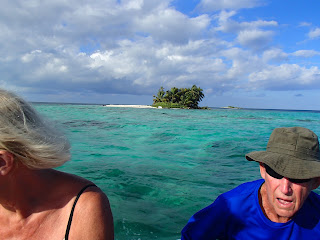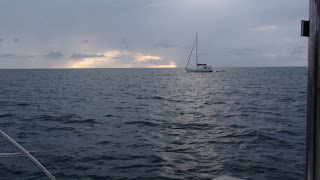Monday, October 15th, 2012
After a
hearty breakfast of pancakes, we slipped the mooring lines, swung about, and
headed due east under engine power for the short trip to Queen's Cays, a
national marine preserve.
We changed course slightly to avoid a lighter colored
patch of shallower water, and then swung around to approach the southernmost
cay heading upwind. We dropped the anchor in 25 feet of water, and after a few
moments it took hold, bringing us to a stop twenty or thirty yards from two
other sailing catamarans already at anchor.
Queen's
Cays, also known as Gladden Spit or Silk Cays is an extended area of very
shallow reef where the surf breaks, at times awash at low tide. There are three
very tiny islands stretched out in a line over about a half mile.
The
southernmost where we and the other boats were anchored has exactly ten short
coconut trees crowded onto a cay that couldn't be more than two hundred feet
long and a quarter that width. It also has one barbeque pit, and a small shack
with men's and women's flush toilets. The cay is also manned during the day by
park rangers who are supposed to collect ten dollars for each crew member
aboard every boat that visits.
Jane stayed
aboard while John, Sheila, Ruth, Mary Anne, and I dinghied in to the pale green
shallow water on the east side of the cay to go snorkeling. I talked to one of
the rangers who informed me that the next cay, about five hundred yards to the
north is a good place to land a small dinghy, and has excellent snorkeling. The
third cay, another five or six hundred yards north of the second is a sanctuary
where birds are nesting, and that nobody is allowed ashore there.
The sandy
bottom is only about two or three feet below the surface, very gradually
sloping out to deeper water. Millions of silvery inch-long fish formed a dense
shimmering layer a few inches about the bottom, parting around me and joining
again behind as I floated along.
 The
transition from sand to dense populations of sea fans and soft corals was rapid
as I swam toward deeper water. Although the water was a bit cloudy, I enjoyed a
good hour of watching the many kinds of fish, and taking underwater pictures
and video.
The
transition from sand to dense populations of sea fans and soft corals was rapid
as I swam toward deeper water. Although the water was a bit cloudy, I enjoyed a
good hour of watching the many kinds of fish, and taking underwater pictures
and video.
Just after
noon, a long open boat with a powerful out board motor on the back, and the
words "Nature Reserve Ranger" stenciled on the bow approached our
boat as it lay at anchor. The two rangers I had seen earlier on the beach cooking
about two dozen chickens on a barbeque grill were aboard, and waved to us. They
had come to collect the park fee. They said that the quoted price of ten
dollars per night, per person was incorrect, and that it was a one-time charge
only. We could stay as long as we liked, but that if we left and then came back
again the fee would be collected again. After handing one of them the $60 for
the six of us on board, the ranger said, "Well, I only have four tickets,
but I can bring you the other two tomorrow if you are still here."
This was
not difficult to figure out. If they had collected sixty dollars, but had to
show the sale only four tickets when they reported to their office, they could
pocket a nice 33% personal profit on the transaction. John was of the opinion
that they likely made only a pittance in salary, and said nothing as he handed
them the full amount. They handed him the four tickets, gunned the outboard in
a sharp turn, and instead of heading back to the cay, raced off straight toward
the deep ocean waters to the east, probably to spend the rest of the day
fishing. Although the cruising guide book said that the Queens Cays are manned
twenty-four hours a day every day, we have not seen a ranger presence since.
After lunch on board we watched two
sailboats pull up anchor and head out, leaving only one more sailboat lying at
anchor with us. A solitary dolphin surfaced a few yards away, took a breath and
submerged again, coming up one more time farther away before disappearing.
The wind
picked up a bit in the afternoon, and far off to the west a dark bank of clouds
appeared. We decided that an afternoon snorkeling trip should be done sooner,
rather than later. This time Ruth and Sheila stayed aboard while the rest of us
stumbled aboard the pitching dinghy, and headed for Middle Queens Cay.
 Approaching the shoaling water from the southeast, the foot and a half to two
foot high swells looked a bit to intimidating, and John swung us around to head
back to the South Queens Cay where we had gone swimming in the morning.
Approaching the shoaling water from the southeast, the foot and a half to two
foot high swells looked a bit to intimidating, and John swung us around to head
back to the South Queens Cay where we had gone swimming in the morning.
The choppy
waves were washing across the shallows, but we hopped overboard onto the white
sandy bottom in three feet of water, taking the tiny anchor out thirty feet
from the front of the dink. Its short eight-inch hooks would not hold in the
soft sand, so I dropped it behind a small head of dead coral.
Although
there is only a foot and a half difference here between high tide and low tide,
this afternoon there was less clearance between the surface of the water and
the tops of the sea fans and soft coral. That, combined with the larger choppy
waves sweeping across the reef made it feel as if you would be deposited on
something unpleasant with each dip into a wave trough.
John and
Mary Ann struck out for deeper water immediately. Jane floated in three to four
foot deep water for awhile before deciding that it was just a bit too
uncomfortable. As we headed for the tiny beach I saw that the dink anchor had
slipped, and was dragging toward the beach, so I retrieved it and reset the
anchor behind a larger coral head.
We ambled
out onto the short sand spit at the southwest end of the tiny cay, watching
tiny hermit crabs scrabbling their tracks across the damp beach while they
avoided the inch-wide holes where ghost crabs appeared every few seconds to
toss sand from their excavated burrows.
The diner
of chicken casserole prepared by Sheila, Mary Ann, and Jane was served on deck,
and we spent the evening there chatting. The sky was partially clear by eight
o'clock, and we spent some time looking at constellations and the gauzy arc of
the Milky Way stretching high across the sky.







WOWOWOWOW! Your trip looks amazing. Love the pictures! Love this country.
ReplyDelete